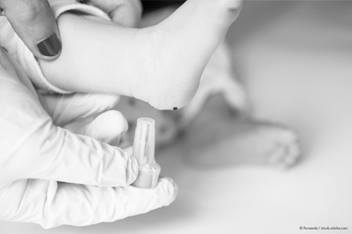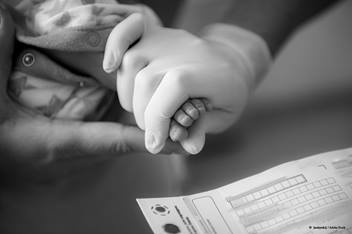Newborn Screening
All babies, born in Ohio, have a blood test at birth called the Newborn Screening Test, which screens for 35 different treatable conditions. Each state has a Newborn Screening Test, but each one tests for a different number of conditions. One of the conditions that all states now screen for is cystic fibrosis. In Ohio, the Newborn Screening Test for cystic fibrosis is done in two steps. The first step is measuring a chemical in the body called immunoreactive trypsinogen (IRT). If the IRT is high, the second test is done. The second test is a genetic test for the most common mutations (gene changes) seen in cystic fibrosis. If at least one mutation is found, this is a “screen positive” result and follow-up testing is needed.
The newborn screen is just a screen for cystic fibrosis. Those with an abnormal (screen positive) newborn screen do not necessarily have cystic fibrosis. Most times (approximately 90%), it is a false positive, meaning the screen was abnormal and the child does not have cystic fibrosis. Instead, the child is a cystic fibrosis carrier. Carriers do not have the condition themselves but are at increased risk to have a child with cystic fibrosis when they have children of their own.
Children with an abnormal newborn screen have a sweat chloride test done. This is the best test we have to figure out if a child has cystic fibrosis or not. For the sweat chloride test to be accurate, it must be done when a child is at least four weeks old. The child must also weigh enough to be able to sweat enough for the test.
The sweat chloride test is usually done on Wednesday mornings at Nationwide Children's Hospital. The family meets with a genetic counselor and/or a pulmonary doctor later that day to discuss the results, concerns or any needs for additional testing. We discuss the results, what it means for the baby and what it means for other family members.
Cystic fibrosis is a genetic condition, which is inherited in an autosomal recessive manner. This means it is an inherited disease affecting both males and females. Cystic fibrosis occurs when a person inherits a particular pair of genes that do not work correctly. The affected person inherits one of these non-working genes from each parent. Usually the parents do not have cystic fibrosis themselves but are carriers of the disease. A carrier is a person who has one working gene and one non-working gene. One in 25 (4%) Caucasians is a carrier of cystic fibrosis. It is less common but still occurs in other ethnic backgrounds. Generally, a carrier has no symptoms of cystic fibrosis because the working gene compensates for the non-working gene. To have a child with cystic fibrosis, both parents must be at least cystic fibrosis carriers.
When both parents are carriers, with each pregnancy, they have a 1 in 4 (25%) chance of having a child affected with cystic fibrosis, a 1 in 2 (50%) chance of having a child who is a carrier, and a 1 in 4 (25%) chance of having a child who does not carry the cystic fibrosis gene at all.
When only one parent is a carrier, with each pregnancy, they have a 1 in 2 (50%) chance of having a child who is a carrier, and a 1 in 2 (50%) chance of having a child who does not carry the cystic fibrosis gene at all.



